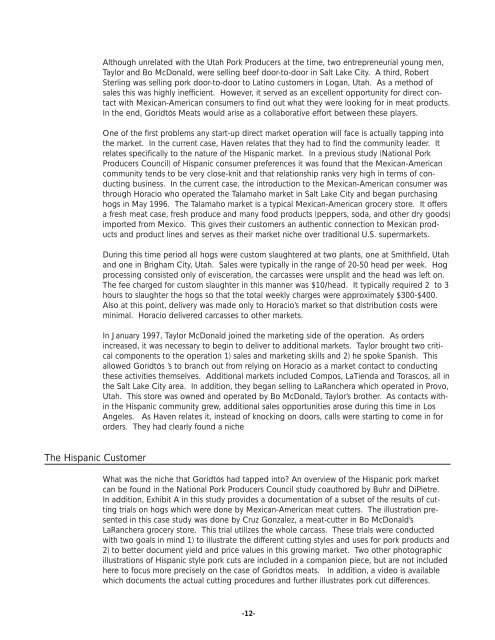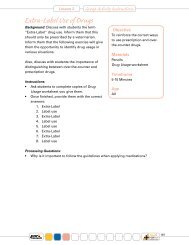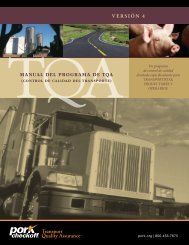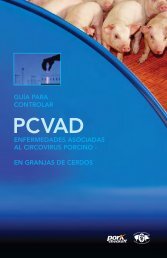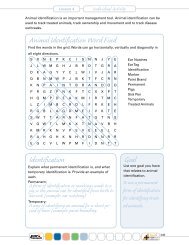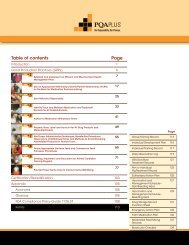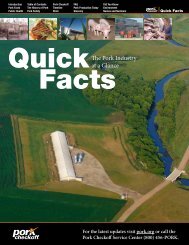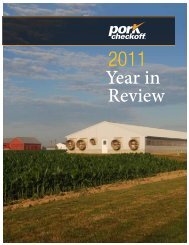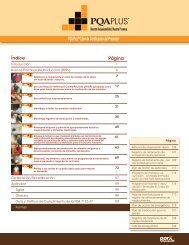Case Studies of Value Added Production and Marketing
Case Studies of Value Added Production and Marketing
Case Studies of Value Added Production and Marketing
Create successful ePaper yourself
Turn your PDF publications into a flip-book with our unique Google optimized e-Paper software.
Although unrelated with the Utah Pork Producers at the time, two entrepreneurial young men,<br />
Taylor <strong>and</strong> Bo McDonald, were selling beef door-to-door in Salt Lake City. A third, Robert<br />
Sterling was selling pork door-to-door to Latino customers in Logan, Utah. As a method <strong>of</strong><br />
sales this was highly inefficient. However, it served as an excellent opportunity for direct contact<br />
with Mexican-American consumers to find out what they were looking for in meat products.<br />
In the end, Goridto ’ s Meats would arise as a collaborative effort between these players.<br />
One <strong>of</strong> the first problems any start-up direct market operation will face is actually tapping into<br />
the market. In the current case, Haven relates that they had to find the community leader. It<br />
relates specifically to the nature <strong>of</strong> the Hispanic market. In a previous study (National Pork<br />
Producers Council) <strong>of</strong> Hispanic consumer preferences it was found that the Mexican-American<br />
community tends to be very close-knit <strong>and</strong> that relationship ranks very high in terms <strong>of</strong> conducting<br />
business. In the current case, the introduction to the Mexican-American consumer was<br />
through Horacio who operated the Talamaho market in Salt Lake City <strong>and</strong> began purchasing<br />
hogs in May 1996. The Talamaho market is a typical Mexican-American grocery store. It <strong>of</strong>fers<br />
a fresh meat case, fresh produce <strong>and</strong> many food products (peppers, soda, <strong>and</strong> other dry goods)<br />
imported from Mexico. This gives their customers an authentic connection to Mexican products<br />
<strong>and</strong> product lines <strong>and</strong> serves as their market niche over traditional U.S. supermarkets.<br />
During this time period all hogs were custom slaughtered at two plants, one at Smithfield, Utah<br />
<strong>and</strong> one in Brigham City, Utah. Sales were typically in the range <strong>of</strong> 20-50 head per week. Hog<br />
processing consisted only <strong>of</strong> evisceration, the carcasses were unsplit <strong>and</strong> the head was left on.<br />
The fee charged for custom slaughter in this manner was $10/head. It typically required 2 to 3<br />
hours to slaughter the hogs so that the total weekly charges were approximately $300-$400.<br />
Also at this point, delivery was made only to Horacio’s market so that distribution costs were<br />
minimal. Horacio delivered carcasses to other markets.<br />
In January 1997, Taylor McDonald joined the marketing side <strong>of</strong> the operation. As orders<br />
increased, it was necessary to begin to deliver to additional markets. Taylor brought two critical<br />
components to the operation 1) sales <strong>and</strong> marketing skills <strong>and</strong> 2) he spoke Spanish. This<br />
allowed Goridto ’ s ’s to branch out from relying on Horacio as a market contact to conducting<br />
these activities themselves. Additional markets included Compos, LaTienda <strong>and</strong> Torascos, all in<br />
the Salt Lake City area. In addition, they began selling to LaRanchera which operated in Provo,<br />
Utah. This store was owned <strong>and</strong> operated by Bo McDonald, Taylor’s brother. As contacts within<br />
the Hispanic community grew, additional sales opportunities arose during this time in Los<br />
Angeles. As Haven relates it, instead <strong>of</strong> knocking on doors, calls were starting to come in for<br />
orders. They had clearly found a niche<br />
The Hispanic Customer<br />
What was the niche that Goridto ’ s had tapped into? An overview <strong>of</strong> the Hispanic pork market<br />
can be found in the National Pork Producers Council study coauthored by Buhr <strong>and</strong> DiPietre.<br />
In addition, Exhibit A in this study provides a documentation <strong>of</strong> a subset <strong>of</strong> the results <strong>of</strong> cutting<br />
trials on hogs which were done by Mexican-American meat cutters. The illustration presented<br />
in this case study was done by Cruz Gonzalez, a meat-cutter in Bo McDonald’s<br />
LaRanchera grocery store. This trial utilizes the whole carcass. These trials were conducted<br />
with two goals in mind 1) to illustrate the different cutting styles <strong>and</strong> uses for pork products <strong>and</strong><br />
2) to better document yield <strong>and</strong> price values in this growing market. Two other photographic<br />
illustrations <strong>of</strong> Hispanic style pork cuts are included in a companion piece, but are not included<br />
here to focus more precisely on the case <strong>of</strong> Goridto ’ s meats. In addition, a video is available<br />
which documents the actual cutting procedures <strong>and</strong> further illustrates pork cut differences.<br />
-12-


